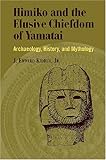Himiko and Japan's Elusive Chiefdom of Yamatai : Archaeology, History, and Mythology / J. Edward Kidder.
Material type: TextPublisher: Honolulu : University of Hawaii Press, [2007]Copyright date: ©2007Description: 1 online resource (448 p.) : 45 illusContent type:
TextPublisher: Honolulu : University of Hawaii Press, [2007]Copyright date: ©2007Description: 1 online resource (448 p.) : 45 illusContent type: - 9780824830359
- 9780824862848
- 952/.01 22
- online - DeGruyter
- Issued also in print.
| Item type | Current library | Call number | URL | Status | Notes | Barcode | |
|---|---|---|---|---|---|---|---|
 eBook
eBook
|
Biblioteca "Angelicum" Pont. Univ. S.Tommaso d'Aquino Nuvola online | online - DeGruyter (Browse shelf(Opens below)) | Online access | Not for loan (Accesso limitato) | Accesso per gli utenti autorizzati / Access for authorized users | (dgr)9780824862848 |
Browsing Biblioteca "Angelicum" Pont. Univ. S.Tommaso d'Aquino shelves, Shelving location: Nuvola online Close shelf browser (Hides shelf browser)

|

|

|

|

|

|

|
||
| online - DeGruyter Heian Japan, Centers and Peripheries / | online - DeGruyter Herself an Author : Gender, Agency, and Writing in Late Imperial China / | online - DeGruyter Hidden Hands and Divided Landscapes : A Penal History of Singapore's Plural Society / | online - DeGruyter Himiko and Japan's Elusive Chiefdom of Yamatai : Archaeology, History, and Mythology / | online - DeGruyter Hirohito and War : Imperial Tradition and Military Decision Making in Prewar Japan / | online - DeGruyter Home in the Islands : Housing and Social Change in the Pacific / | online - DeGruyter House-Girls Remember : Domestic Workers in Vanuatu / |
Frontmatter -- Contents -- Illustrations and Tables -- Acknowledgments -- Introduction -- CHAPTER 1. Ancient Texts and Sources -- CHAPTER 2. The Wei Zhi and the Wa People -- CHAPTER 3. The Initial Problem and Three Centuries of Compounding It -- CHAPTER 4. Travel by Land and Water to Neighboring Countries -- CHAPTER 5. Han Commanderies, Korean Kingdoms, and Wei China -- CHAPTER 6. Japan in Transition from Yayoi to Kofun -- CHAPTER 7. The Izumo-Yamato Contention -- CHAPTER 8. Himiko, Shamans, Divination, and Other Magic -- CHAPTER 9. Mirrors and Himiko's Allotment -- CHAPTER 10. The Japanese View of the Wei Zhi Years -- CHAPTER 11. The Endless Search for Yamatai -- CHAPTER 12. Makimuku and the Location of Yamatai -- List of Abbreviations -- Notes -- Wei Zhi Text -- Select Glossary -- Bibliography -- Index -- About the Author
restricted access online access with authorization star
http://purl.org/coar/access_right/c_16ec
The third-century Chinese chronicle Wei zhi (Record of Wei) is responsible for Japan's most enduring ancient mystery. This early history tells of a group of islands off the China coast that were dominated by a female shaman named Himiko. Himiko ruled for more than half a century as head of the largest chiefdom, traditionally known as Yamatai, until her death in 248. Yet no such person appears in the old Japanese literature. Who was Himiko and where was the Yamatai she governed? In this, the most comprehensive treatment in English to date, a senior scholar of early Japan turns to three sources-historical, archaeological, and mythological-to provide a multifaceted study of Himiko and ancient Japanese society.
Issued also in print.
Mode of access: Internet via World Wide Web.
In English.
Description based on online resource; title from PDF title page (publisher's Web site, viewed 02. Mrz 2022)


